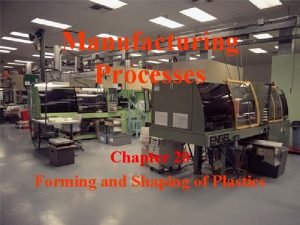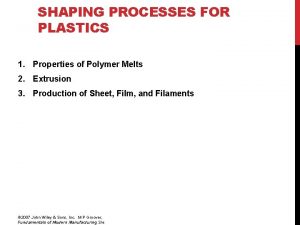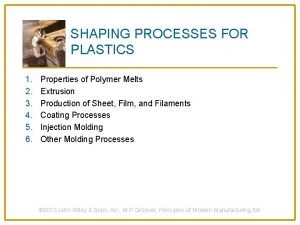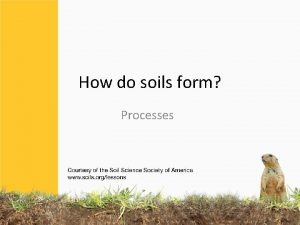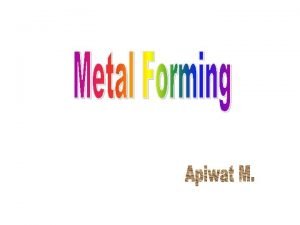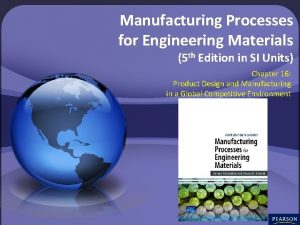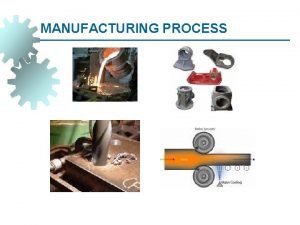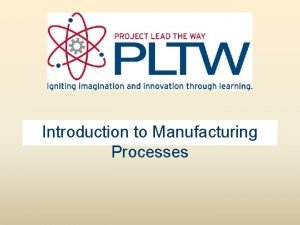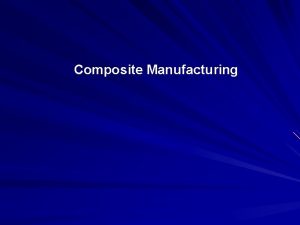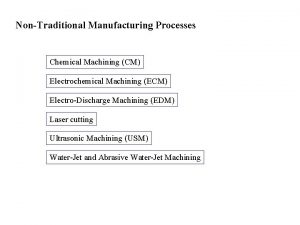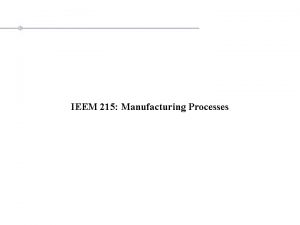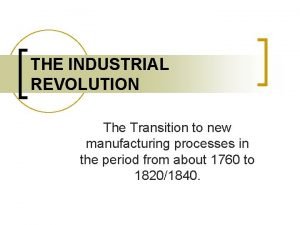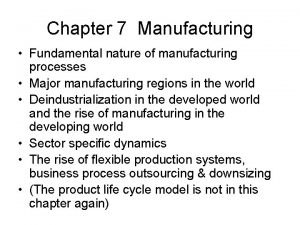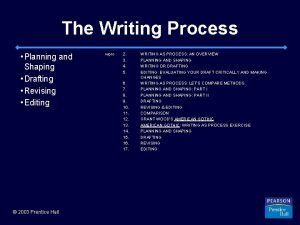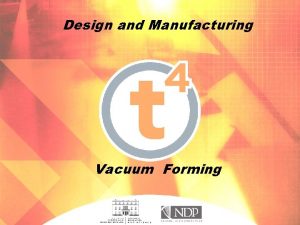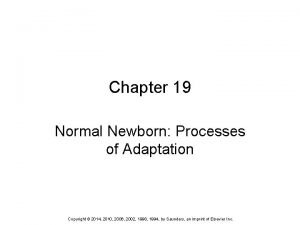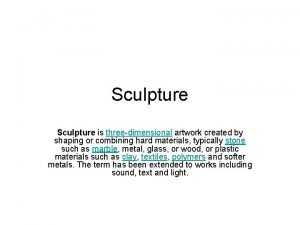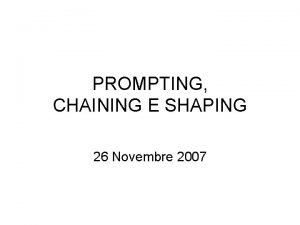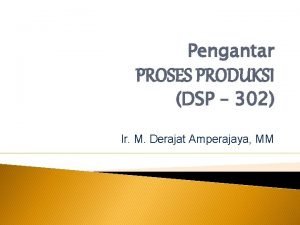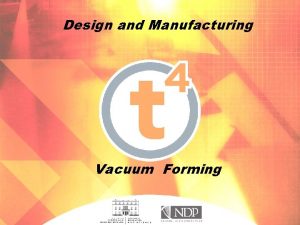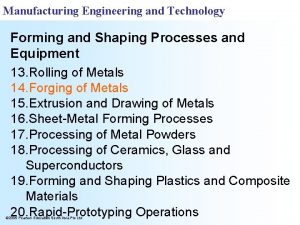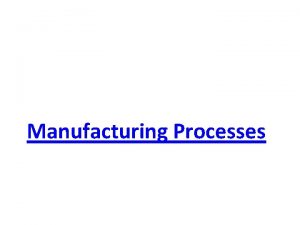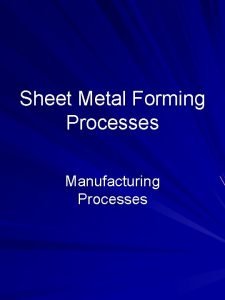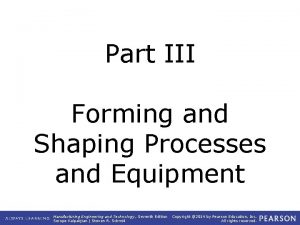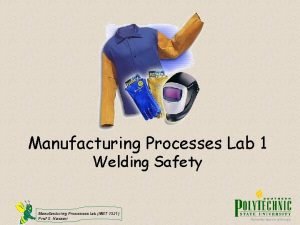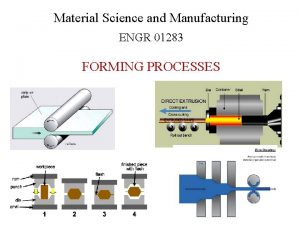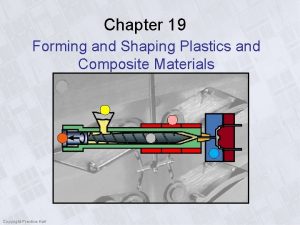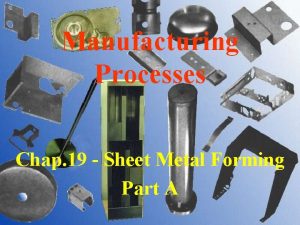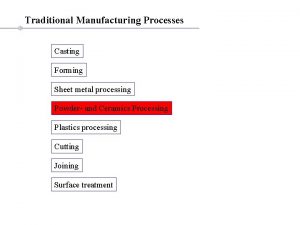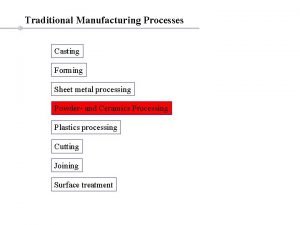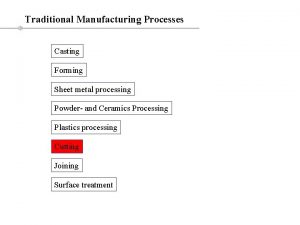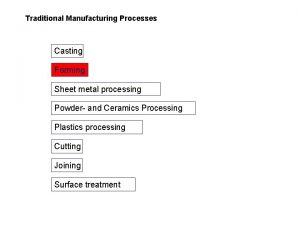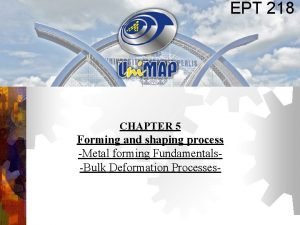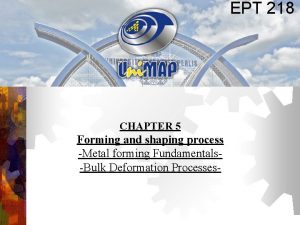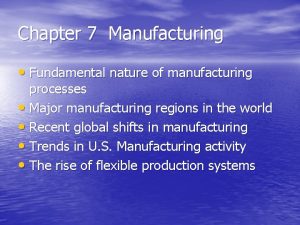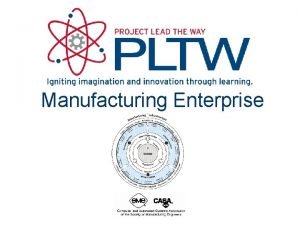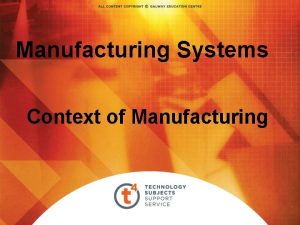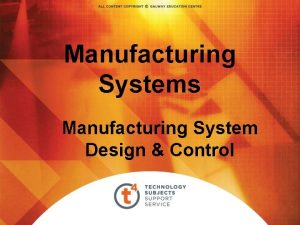Manufacturing Processes Chapter 20 Forming and Shaping of











































- Slides: 43

Manufacturing Processes Chapter 20 Forming and Shaping of Plastics

Plastics Review • Thermoplastics (TPs) – Polymers in which, after heating and cooling, properties return to original values. – Behavior depends on: structure, composition, temperature, rate of deformation. – Glass transition temperature (Tg): the temperature at which the transition in behavior (solid to liquid) takes place. – Below Tg, behavior is like an elastic solid.

Plastics Review • Thermoplastics (TPs) – Plastics have a high strain-rate sensitivity exponent (m). – This enables them to undergo high deformation before fracture. – When a plastic undergoes tensile stresses, the plastic changes in color due to the formation of microvoids. – The material becomes translucent. – This phenomena is referred to as Stress Whitening.

Commonly Known Thermoplastics – Acrylics – Polystyrene – Polycarbonates – Polyesters – Polytetrafluoroethylene (Teflon) – Polyethylene – Polyurethane – Polypropylenes – Polyvinyl Chloride (PVC) Vinyl See last slide for commercial names.

Plastics Review • Thermosets (TSs) – Long molecules are cross-linked three-dimensionally during polymerization – This creates one big molecule and a complex 3 D structure. – The name thermoset is due to the fact that the polymerization is complete and the final shape is set. – The reaction, in this case is IRREVERSIBLE. – Thermosets are rarely used in injection molding.

Plastics Review • Thermosets (TSs) – Thermosets have no set glass Transition temperature (Tg). – Temperature and Rate of Deformation do not affect the strength and hardness of thermosets. – Sample products: knobs, handles, switches.

Commonly Known Thermosets • Epoxy • Melamine • Natural Rubber • Polyester • Silicone. See last slide for more info.

Plastics Review • Biodegradable Plastics – The disposal of plastic products is a major concern, given the limited landfill space available. – Degrade over time with exposure to microorganisms in soil and water. • Some bioplastics available: – Starch-based: a pelletized form of starch is added to the plastic during processing. – Lactic-based: Lactic acid is polymerized to form a polyester resin. – Sugar-based.

Plastics Review • Elastomers (Es) & Rubbers – Amorphous polymers having a very low Tg. – Can undergo large elastic deformation without rupture. – Soft. – Very low Elastic Modulus – Return to original shape after an applied load is removed. – Rubber is a good example of cross-linked polymer. Its hardness increases with increased cross-linking of molecular chains.

Forming and Shaping of Plastics • Plastics can be shaped easily into many shapes with few operations. • Plastics melt at relatively low temperatures. • Properties of resulting parts depend on manufacturing method, process parameters.

Most common methods for Plastic Forming 1. 2. 2 a. 3. 4. 5. Extrusion Injection Molding Reaction Injection Molding Structural Foam Molding Blow Molding Rotational Molding 6. Thermoforming 7. Compression Molding 8. Transfer Molding 8 a. Foam Molding 9. Casting 10. Cold Forming

1. Extrusion • Raw Material: thermoplastic pellets, granules or powder. • Material is placed in hopper and fed into extrusion barrel. • Screw inside barrel blends pellets and conveys them down barrel. • Heaters and friction heat pellets and liquify them.

1. Extrusion (cont. ) • Screw – Feed section: conveys material from hopper to center of barrel. – Transition region: where melting begins. – Pumping section: where shearing, melting and pressure buildup begins.

1. Extrusion (cont. ) • You can adjust the length of these sections depending on the melting characteristics of different plastics. • Once molten plastic is fed through die, it is air-cooled or via cooling tubes. • Cooling rate is critical to avoid shrinkage, distortion. • Can make long sections with no problem due to continuous feed from hopper.

1. Extrusion (cont. ) • Sheet film extrusion – Performed with a flat extrusion die. (See figs. 18. 3, 4) – Plastic bags are made with an extruder (blown film process). – Thin walled tube is extruded vertically upward. – Air is blown through center and expand into a balloon shape. – Balloon is air cooled, blown film is wound up.

2. Injection Molding • A barrel is heated to promote melting. • Friction promotes heating dramatically. • Pellets are fed into heated cylinder. • Melt is forced into split die chamber by hydraulic plunger or rotating screw. • Thermosets require that mold be heated as well to promote polymerization & cross-linking. • Part cools (if thermoplastic) or cures (if thermoset). • Mold is opened, part is ejected.

2. Injection Molding (cont. ) • Mold components: – Runners – Cores – Cavities – Cooling Channels – Inserts – Knockout pins – Ejectors

2. Injection Molding (cont. ) • Other metal components can be placed inside the mold. • They become integral part of the product. – Example: electrical connectors/components. • Multi-component injection molding allows forming of parts having different shapes/colors. – Example: tail light lenses for automobiles.

2. Injection Molding (cont. ) • Process capabilities – Can achieve good dimensional accuracy, complex shapes. – Cycle time ranges 5 -60 seconds. – Molds made of tool steels -cost: hundreds of thousands. – Must justify expenditure with high volume production. – Cycles: • Steel molds: 2 million cycles - Aluminum 10, 000 cycles.

2. Injection Molding (cont. ) • Machines – Injection molding machines are typically horizontal (fig. 18. 7) – Typical pressures in injection molding: 10, 000 30, 000 psi. – Forces range from 100 to 250 tons. – Largest machine: 5000 tons - makes parts up to 55 lbs.

3. Injection Molding (cont. )

2 a. Reaction Injection Molding • Resin and catalysts are forced into mold cavity at high speed. • Reaction is fast, part solidifies into a thermoset. • Can add reinforcing fibers to increase product strength & stiffness. – Typical parts: bumpers, fenders, water skis.

3. Structural Foam Molding • Used to make plastic products with a solid outer skin and a cellular inner structure. • Injection Foam Molding uses a blowing agent (Nitrogen gas) to expand the material. • Can create skin thicknesses as much as 2 mm. • Good stiffness to weight ratio. – Typical parts: furniture parts, TV shells, computer printer housings.

3. Structural Foam Molding

4. Blow Molding • Extrusion Blow Molding – A tube is extruded & then clamped into a mold with larger cavity cross section. . – Tube is blown outward to fill cavity (50 - 100 psi). – All ends of mold close in as air is injected into tubular piece. – Part is cooled and ejected.

4. Blow Molding • Injection Blow Molding – A short piece tubular piece is mold-injected (called the parison). – Dies open, parison is transferred to blowmolding die. – Hot air is injected, expands to walls of cavity. • Typical products: plastic bottles, hollow containers, shampoos.

4. Blow Molding

5. Rotational Molding • Can form large hollow parts by this method. – Two piece mold is designed such that it can be rotated about 2 perpendicular axes. – Pre-measured amount of powder plastic is placed inside warm mold. – Mold is heated further and rotated about the two axes. – Powder tumbles against mold walls, causing it to fuse without melting. – Additional cross-linking occurs via a chemical agent. • Typical products: trash cans, buckets, toys, boat hulls.

6. Thermoforming • Used forming TP sheet or film over a mold. • Done by applying heat and pressure. – Sheet is heated to the sag point (soft but not to he point of melting) – Sheet is taken form oven, placed over mold, forced against it via a vacuum. – Mold is at room temp. , and plastic takes shape of mold immediately.

6. Thermoforming (cont. ) – Material undergoes drawing (vertically) and stretching (horizontally). – It must exhibit high uniform elongation (high m). – Parts with holes cannot be made by this method. – Typical products: refrigerator liners, packaging, appliance housings.

7. Compression Molding • Very similar to forging. • A pre-measured amount of material is placed into heated mold cavity. • Dies are moved/pressed together, forming the part. • An amount of flash results, which is trimmed off.

7. Compression Molding (cont. ) • Primarily for TSs: material is partially polymerized prior to molding. • Cross linking is finished in heated die: times range from ½ to 5 minutes. • Typical parts: dishes, container caps, handles, washing machine agitators.

8. Transfer Molding • Similar to Compression Molding, but dies are not preheated. • Friction caused by ram forcing material into mold generates frictional heat. • Heat makes material homogenous. • Curing takes place by cross linking – Typical parts: electrical connectors, rubber and silicone parts.

8 a. Foam Molding • Polystyrene beads are placed in mold cavity. • Heat is added via steam and air. • Beads expand as much as 50 times to take shape of mold. • Expansion is controlled by varying time and temperature. – Typical products: styrofoam cups, food containers, packaging materials for appliances.

8 a. Foam Molding (cont. ) • Can also use polyurethane foam. • Mix two or more chemicals to form a cellular structure. • This fills and solidifies in mold. – Typical uses: auto seat cushions, insulation, packaging.

9. Casting • Some TPs (nylons, acrylics) and TSs (epoxies, polyester) can be cast in rigid or flexible molds. • Conventional Casting: – TPs: create mixture of monomer, catalyst, heat and pour into mold – Polymerization occurs at ambient pressure.

9. Casting (cont. ) • Potting & Encapsulation: – Involves casting the plastic around another component to embed it in the plastic. – Typical applications: electrical plugs, coils, solenoids, electronic ignitions.

10. Cold Forming Processes • Processes used to form many TPs at room temperature (cold forming) (10 - 20 deg C) • Processes include rolling, extrusion, deep drawing, others. • Materials include ABS, PVC, polypropylene, polycarbonate.

10. Cold Forming Processes • Materials for cold working must: – be ductile at room temp. (This eliminates polystyrene, acrylics, thermosets. ) – not recover from deformation. • Cold forming of plastics creates products with higher strength, toughness.

10. Cold Forming Processes • Elastomers – Usually by extrusion or injection molding, but also blow molding and thermoforming – Typical products: tubing, hoses, molding, inner tubes. • Rubber gloves are made by dipping a metal form (a hand) many times in a liquid compound that adheres to form, which is later vulcanized and stripped.

Summary

Some Common Thermoplastics

Some Common Thermosets
 Shaping manufacturing process
Shaping manufacturing process Shaping processes for plastics
Shaping processes for plastics Shaping processes for plastics
Shaping processes for plastics 4 soil forming processes
4 soil forming processes Flashless forging process
Flashless forging process Manufacturing cost vs non manufacturing cost
Manufacturing cost vs non manufacturing cost Manufacturing cost vs non manufacturing cost
Manufacturing cost vs non manufacturing cost Manufacturing cost vs non manufacturing cost
Manufacturing cost vs non manufacturing cost Manufacturing cost vs non manufacturing cost
Manufacturing cost vs non manufacturing cost Additive manufacturing steps
Additive manufacturing steps Manufacturing process for engineering materials
Manufacturing process for engineering materials Classification of manufacturing processes
Classification of manufacturing processes List of manufacturing processes
List of manufacturing processes Composite manufacturing process
Composite manufacturing process Nontraditional manufacturing processes
Nontraditional manufacturing processes Traditional manufacturing processes
Traditional manufacturing processes The transition to new manufacturing processes
The transition to new manufacturing processes Nature of manufacturing process
Nature of manufacturing process Concurrent in os
Concurrent in os Section 3 shaping evolutionary theory
Section 3 shaping evolutionary theory Chapter 15 section 3 shaping evolutionary theory
Chapter 15 section 3 shaping evolutionary theory Chapter 8 designing and managing service processes
Chapter 8 designing and managing service processes Demand sensing and shaping
Demand sensing and shaping Shaping and planning process
Shaping and planning process Open center curls
Open center curls Relaxation vocabulary
Relaxation vocabulary What is prototype
What is prototype Www.feedbackrewards.com today
Www.feedbackrewards.com today Casting forming and welding mcq
Casting forming and welding mcq Forming and solving equations
Forming and solving equations Constructing equations worksheet
Constructing equations worksheet Advantage of cold working
Advantage of cold working Vacuum forming companies near me
Vacuum forming companies near me Boring comparativo
Boring comparativo Forming and solving equations worksheet
Forming and solving equations worksheet Chapter 19 normal newborn processes of adaptation
Chapter 19 normal newborn processes of adaptation Shaping e chaining esempio
Shaping e chaining esempio What is shapping
What is shapping Shaping 2030
Shaping 2030 A process in sculpture putting additional parts
A process in sculpture putting additional parts Esempi di prompting
Esempi di prompting Precision fluency shaping program
Precision fluency shaping program Shaping process adalah
Shaping process adalah Palo alto traffic shaping
Palo alto traffic shaping
